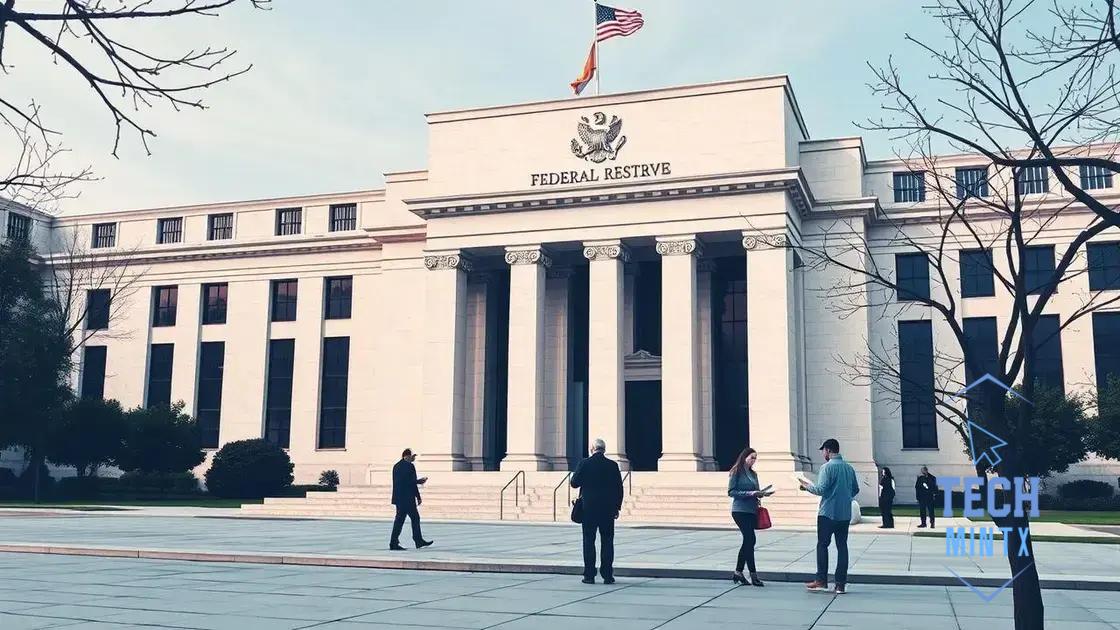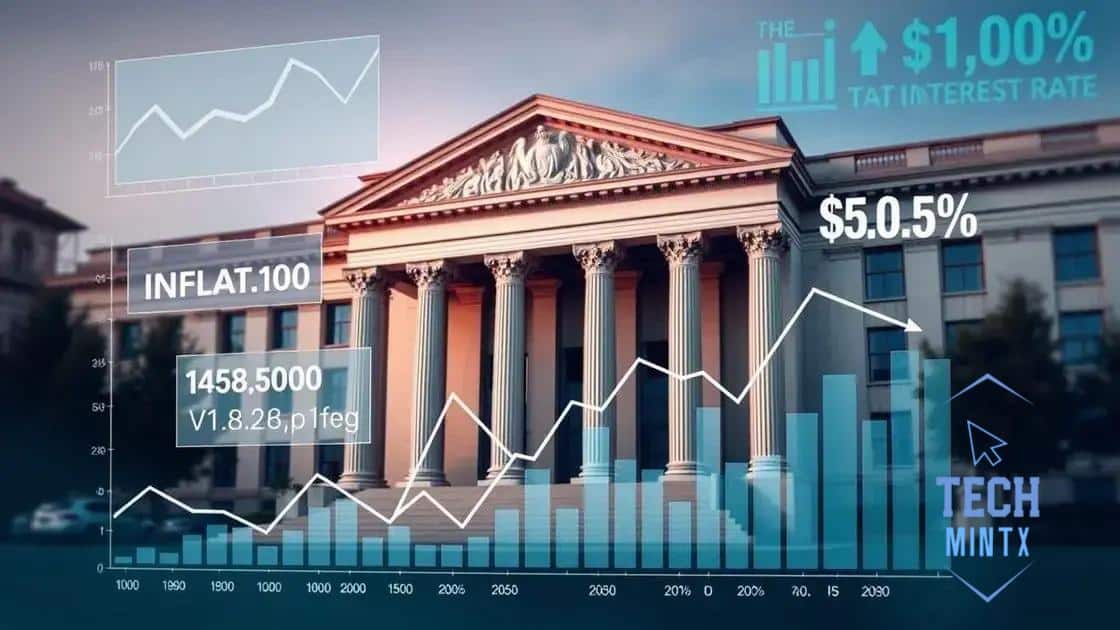Federal Reserve’s potential interest rate adjustments explained

The Federal Reserve’s potential interest rate adjustments directly impact borrowing costs, consumer spending, business investment, and overall economic stability, guided by factors like inflation and employment levels.
Federal Reserve’s potential interest rate adjustments play a crucial role in shaping the economy. Have you ever wondered how these changes can influence your everyday financial decisions? Let’s dive in.
Understanding the Federal Reserve’s role
Understanding the Federal Reserve is essential for grasping how our economy functions. The Federal Reserve, often referred to as the Fed, acts as the central bank of the United States. Established in 1913, it plays a crucial role in managing the nation’s monetary policy.
One primary responsibility of the Fed is to regulate and oversee the banking system. This ensures the stability of financial institutions and maintains public confidence in our currency. Additionally, the Fed strives to promote maximum employment, stable prices, and moderate long-term interest rates.
The Functions of the Federal Reserve
The Federal Reserve has several key functions that help it achieve its goals. These functions include:
- Setting monetary policy
- Regulating banks and ensuring financial stability
- Providing financial services to the government
- Facilitating smooth payment systems
Through these functions, the Fed influences the economy in profound ways. For example, when adjusting interest rates, it impacts how much borrowers pay and how much savers earn. Lowering interest rates can encourage more borrowing and spending, while raising them can help cool down an overheating economy.
Moreover, the Federal Reserve conducts research and analysis to better inform its policy decisions. By studying economic indicators, the Fed can adjust its strategies to meet its objectives. This dynamic approach is crucial for navigating the ever-changing landscape of the economy.
The Importance of Transparency
Transparency is vital for the Federal Reserve’s credibility and effectiveness. Regular communication with the public helps manage expectations about future monetary policy. By understanding the Fed’s intentions, businesses and consumers can make informed financial decisions.
In summary, understanding the role of the Federal Reserve sheds light on how monetary policy shapes our economic environment. Its various functions work together to maintain a stable economy, ultimately affecting everyone from individual consumers to large corporations.
Factors influencing interest rate changes

Several factors influence interest rate changes, and understanding these can help individuals and businesses make better financial decisions. The Federal Reserve carefully monitors various economic indicators to determine when to alter interest rates. This process is essential for maintaining economic stability and growth.
One key factor is inflation. When inflation rises, the purchasing power of money decreases. To counter this, the Federal Reserve may increase interest rates to stabilize prices. Conversely, if inflation is low, the Fed might lower interest rates to encourage borrowing and spending.
The Role of Economic Growth
Economic growth plays a significant part in interest rate decisions. If the economy is growing too quickly, it can lead to overheating and inflation. In this scenario, the Fed might raise rates to cool off the economy. On the other hand, during slow growth periods, lowering rates can stimulate spending and investment.
- Strong economic indicators often lead to higher rates.
- Weak economic performance can result in lower rates.
- Consumer confidence affects spending and the overall economy.
- Global economic trends can also have significant impacts.
Another influencing factor is employment levels. Low unemployment generally leads to increased consumer spending, which can fuel inflation. If job growth is strong, the Fed might consider raising rates. Alternatively, high unemployment may prompt the Fed to lower rates to stimulate job creation and economic activity.
Additionally, external factors such as geopolitical events, market volatility, and changes in trade policy can impact interest rates. The Fed must remain agile, adjusting its strategies based on both domestic and international economic conditions. By analyzing all these factors, the Federal Reserve aims to maintain a delicate balance that fosters growth while controlling inflation.
Potential impacts on consumers and businesses
The potential impacts of interest rate changes on consumers and businesses can be significant. Understanding these effects can help individuals and companies navigate their financial decisions more effectively. When the Federal Reserve adjusts interest rates, it influences borrowing costs for loans and credit.
For consumers, higher interest rates mean that loans for homes, cars, and credit cards become more expensive. This can lead to reduced consumer spending because people may be less willing to take on debt. Less spending can slow down economic growth as businesses face lower demand for their products and services.
Effects on Borrowing and Spending
When interest rates rise, it generally discourages borrowing. For businesses, this can mean:
- Higher costs for loans used to expand operations.
- Increased expenses for maintaining existing debt.
- Delayed investments in new projects and technologies.
- Potential layoffs if economic activity slows down significantly.
As a result, businesses may choose to hold off on hiring new employees or investing in new initiatives until they feel more secure about the economic outlook.
On the other hand, when interest rates fall, borrowing becomes cheaper. This encourages both consumers and businesses to borrow more. Consumers are more likely to take out loans for big-ticket items, and businesses may invest in growth opportunities. Increased consumer spending can drive economic growth, making lower interest rates generally favorable.
Long-term Implications
In the long term, persistent high-interest rates can lead to economic instability. If consumers and businesses limit their spending due to high costs of borrowing, it could spur a recession. Conversely, low rates can help stimulate an economy recovering from downturns. It’s essential for stakeholders to be aware of how these changes can affect their financial strategies.
Monitoring interest rates and understanding their implications empowers both consumers and businesses to make informed decisions. Staying informed about the monetary policy of the Federal Reserve is vital for anyone looking to navigate the complexities of the economy successfully.
Historical trends of interest rate adjustments

Examining historical trends of interest rate adjustments offers valuable insights into how the Federal Reserve has responded to various economic challenges over the decades. By analyzing past actions, we can see patterns and understand the factors that drive changes in monetary policy.
For instance, during periods of high inflation, such as the late 1970s and early 1980s, the Fed raised interest rates significantly. This was a response to soaring prices and was aimed at stabilizing the economy. The rates peaked at around 20% in 1981, showcasing the drastic measures taken to control inflation.
Interest Rates and Economic Crises
Interest rate adjustments are often influenced by economic crises. After the dot-com bubble in the early 2000s, the Fed lowered rates to stimulate growth. Following the 2008 financial crisis, rates were brought down to near zero to encourage borrowing and economic recovery. This marked one of the most extended periods of low interest rates in U.S. history.
- In the 1980s, high inflation led to aggressive rate hikes.
- Post-2008, the Fed used low rates to combat recession.
- Changes in global economics also influenced U.S. rates.
- Technological growth and market shifts altered how rates are adjusted.
In recent years, the Fed has begun to raise rates again in response to a strengthening economy and concerns about inflation. The process of adjusting rates is carefully calculated, with the Fed using economic data and forecasts to guide their decisions.
Every adjustment reflects broader economic trends, including unemployment rates, consumer spending, and global financial conditions. Understanding these historical trends enhances our grasp of current monetary policy and its potential future direction.
Future outlook for interest rates
The future outlook for interest rates remains uncertain and is influenced by various economic factors. Monitoring these trends can provide insight into what consumers and businesses might expect in the coming years. The Federal Reserve’s decisions on interest rates will largely depend on inflation, employment, and economic growth.
Inflation trends will be a crucial factor. If prices continue to rise, the Fed may decide to increase interest rates to cool down the economy. A sustained increase in rates would impact borrowing costs, making loans more expensive and potentially slowing consumer spending.
Employment and Economic Growth
Another key aspect to consider is the state of the labor market. Low unemployment levels often lead to higher wages, which can contribute to inflation. As the economy continues to recover, the Fed might need to adjust rates to balance growth and price stability.
- If job growth remains strong, higher rates could be on the horizon.
- Weak job numbers may prompt the Fed to keep rates low for longer.
- The global economy will also play a role in shaping U.S. interest rates.
- Trade relations and geopolitical events can influence monetary policy.
Additionally, consumer confidence plays a significant role in economic growth. If consumers feel secure about their finances, they are more likely to borrow and spend. This can drive the economy forward, prompting the Fed to consider rate hikes as a means of managing economic expansion.
Ultimately, the outlook for interest rates will depend on how these various factors evolve. Observers should pay close attention to incoming economic data and Fed announcements, as they will provide crucial information about future interest rate adjustments. By staying informed, both consumers and businesses can prepare for potential changes in the economic environment.
FAQ – Questions about Interest Rate Adjustments
What factors influence interest rate changes?
Factors include inflation, employment levels, global economic conditions, and consumer confidence, all of which affect how the Federal Reserve sets rates.
How can rising interest rates affect consumers?
Rising interest rates can make loans more expensive, leading to reduced consumer spending on big-ticket items like homes and cars.
What impact do interest rate changes have on businesses?
Businesses may face higher borrowing costs, which can delay expansions and investment decisions, ultimately affecting growth.
Why is it important to monitor interest rate trends?
Monitoring trends helps consumers and businesses make informed financial decisions and prepares them for potential changes in the economic environment.





